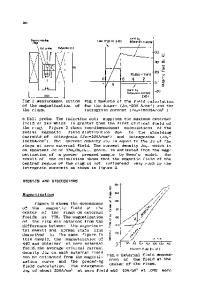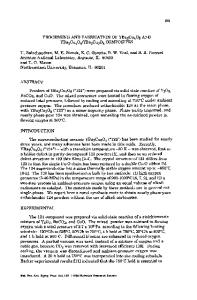X-Ray Absorption Studies of Vanadium-Containing Yba 2 Cu 3 O 7
- PDF / 287,784 Bytes
- 4 Pages / 420.48 x 639 pts Page_size
- 104 Downloads / 273 Views
X-RAY ABSORPTION STUDIES OF VANADIUM-CONTAINING YBa2Cu307 Z. TAN,* J. I. BUDNICK,* W. Q. CHEN,* B. R. WEINBERGER,+ and L. LYNDS+ * University of Connecticut, Physics Department and Institute of Materials Science, Storrs, CT 06269. + United Technologies Research Center, East Hartford, CT 06108. ABSTRACT Attempted V substitution leads to small but observable lattice expansions of the YBa 2 Cu30 7 main phase but has little effect on the superconducting transition temperature. X-ray absorption spectra at the K-edges of V, Cu and Y and L3-edge of Ba have been measured on vanadium-containing YBa 2Cu 3O7 to address the question of V substitution in this material. We found that only a small amount of V can substitute into the YBa 2Cu 30 7 structure. The excess V forms an impurity phase in which V is tetrahedrally coordinated with oxygens. INTRODUCTION Rare earth (RE) and transition metal (TM) substitutions in the YBa 2 Cu307 superconductors have been widely studied. The superconducting properties are only weakly or not at all affected by most RE element substitution for the Y atom [1]. Substitutions at the Cu site(s), typically by a 3d TM element, generally degrades superconductivity and may result in structural phase transitions. The degradation of superconductivity depends on the type of substituents and depends on which Cu site is substituted [1]. Considering that vanadium exhibits a rich variety of valence states and coordination geometries in its compounds [2], we have synthesized YBa2Cu30 7 materials with attempted V substitutions by a wet chemical method. X-ray absorption (XAS) studies combined with x-ray diffraction (XRD) and magnetization measurements have been carried out to learn about the V environment and its effect on the structure and superconductivity of YBa 2 Cu30 7 .
EXPERIMENTAL All V-containing Y-Ba-Cu-O samples studied herein were synthesized using BaCO3, CuO, Y2 0 3 , and V205 which were dissolved and stirred in hot concentrated nitric acid and boiled to obtain dry powders. The atomic-scale homogeneity of mixing obtained this way is essential for the studies of impurity substitution. The resulting powder was pressed into disks which were sintered in air at 8500C for 24 h. After one intermediate grinding, disks were pressed and annealed in dry oxygen at 9300 C for 16 h followed by slow cooling through 700 0 C. X-ray diffraction measurements using a Cu Ka source were made on powders mixed with a germanium calibration standard. Powder patterns in the 20-700 range of 215 and detailed spectra of the [0061, [0201 and [200] YBa2Cu3O 7 reflections (450-48o) were acquired. X-ray absorption measurements were carried out at Beam Line X-1 1A at the National Synchrotron Light Source (NSLS) using a Si(l 11) double crystal monochromator. The energy of the V K-edge is between those of the Ba L3 and L 2 edges, so only the near-edge (XANES) spectrum was obtained in the fluorescence mode using a 9~x=6 Ti filter which eliminates the background from scattering and the strong Ba fluorescence signal. The Cu spectra were me
Data Loading...











